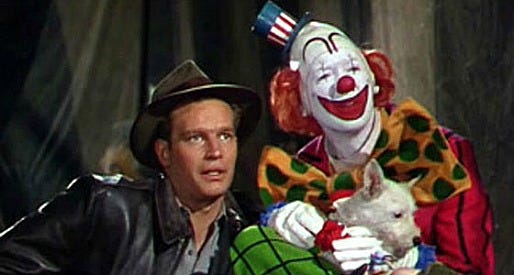The Greatest Show on Earth (1952)

A while back, I took a look at one of the films often mentioned in discussions about the worst movies ever to win the Best Picture Academy Award, "Around the World in 80 Days." That compelled me to seek out more "bottom dwellers" from Oscar history — though being sneered at as "the worst of the best" is not really too crushing an insult, if you think about it.
"The Greatest Show on Earth" hearkens back to a time when audiences craved sheer spectacle for its own sake. That this 1952 picture produced and directed by Cecil B. DeMille has in spades, showing both the real show of the Ringling Bros. and Barnum & Bailey's Circus troupe while mixing in a behind-the-scenes story laden with romance and intrigue.The back-of-the-show parts aren't nearly as good as the front, but it's still an agreeable piece of entertainment, even if it could easily have lost one-fifth of its 2½-hour runtime.
"Show" was not up against a weak field in the Oscar race its year. "High Noon" was the heavy favorite to win, and may have been undermined by its anti-McCarthy themes. "The Quiet Man" and "Moulin Rouge" were also strong contenders, though "Ivanhoe" does not hold up well. Heck, the masterful "Singin' in the Rain," generally regarded as the greatest film musical ever, did not even merit a Best Picture nomination. It has been noted that "Show" is one of only a couple of films to win Best Picture without also receiving nominations for both director and screenplay. (The other is "Gladiator.") While it has occasionally happened that a Best Pic saw its director shut out ("Driving Miss Daisy") or its screenwriter(s), it's exceedingly rare for it to happen to both. It did earn a "Best Story" nomination at a time when the Academy still had that category.
The consensus of film historians is that "Show" was seen in the industry at the time as the last, best chance to give an Academy Award to the legendary DeMille, whose career was winding down. The Oscars have a long history of "make-up" awards to reward people who deserved a golden statuette but never got one through various circumstances. (See: Newman, Paul, "The Color of Money.") Little did they know that in 1956 he would go on to direct "The Ten Commandments," possibly his greatest cinematic triumph. In a bit of ironic turnaround, DeMille, having been the beneficiary of the one of the greatest upsets in Oscar history, saw his grand epic beat out by — you guessed it — "Around the World in 80 Days." There's some kind of cosmic harmony in that series of events.
About half of the screen time is given over to footage of the show in progress, which is essentially just filming what the circus really did touring around the country. This was a time when kids from rural areas might only ever see a elephant or a tiger or lion when the circus came to town — not to mention trapeze artists, clowns and so forth. There's also quite a bit of documentary-style peeks at the monumental logistics behind moving around an entire circus operation of 1,400 people. A lot of this is pretty dull stuff, though the actual raising of the big top is pretty interesting. (This is also the only section of the movie where you'll see any people of color.) The story part is pretty simple. Charlton Heston plays Brad, the whip-cracking boss who keeps everything running on time. He's sweet on Holly (Betty Hutton), the young trapeze star who's set to take over the center ring. Until, that is, Brad recruits the Great Sebastian (Cornel Wilde), a famous ladykiller who only works in the limelight.
Sebastian takes a shine to Holly, who uses this to make Brad jealous. In turn, he is wooed by Angel (Gloria Grahame), the elephant performer who's been around the block a few times. Also hanging around is Phyllis (Dorothy Lamour), who performs an "iron jaw" hanging act as well as sings in a big island musical number.
The two high points of the narrative are Sebastian falling during a dangerous battle of one-upsmanship with Holly, and the big train wreck near the end that threatens to shut the circus down permanently. There are also confusing subplots involving a mobster, a cheating carny and a German trainer who's green-eyed for Angel.
The big problem with "The Greatest Show on Earth" is it couldn't decide if it wants to be a journalistic look at what goes into putting on a major circus or a schmaltzy Hollywood story set against a circus backdrop. It tries to do both, and as a result neither part is thoroughly successful, though the show part wins a contest between them.
I haven't even mentioned Jimmy Stewart as Bubbles, a sympathetic clown who never removes his makeup and seems much more worldly than a clown should, particularly when it comes to medical matters. (At one point, he's able to diagnose that Sebastian's mangled rictus arm should make a full recovery just by watching him try to throw a punch at Brad.)
He's got his own backstory about being a wanted murderer on the lam, a doctor who performed a mercy killing for his sick wife. I enjoyed Stewart's antics as a clown — like the rest of the cast, he actually spent time living and training with the real circus performers. However, his character and tale don't carry much emotional weight, also just like the rest of the cast.
"The Greatest Show on Earth" is very much like going to the circus. There are momentary thrills and chills, a few scary moments, some funny scenes and a whole lot of mushy stuff. Then you go home and, after a while, you forget about it. Worthy Best Pictures can be many things, but the one thing they should not be is forgettable.
3.5 Yaps



